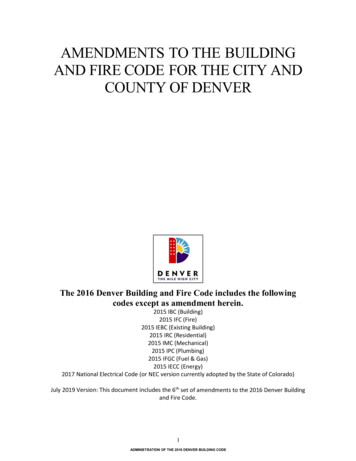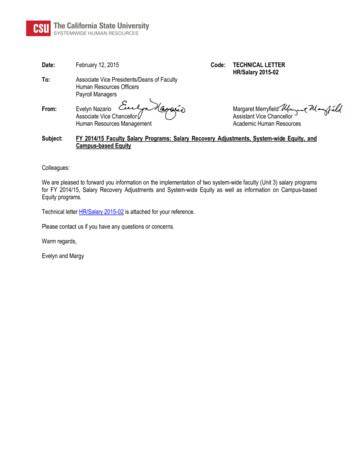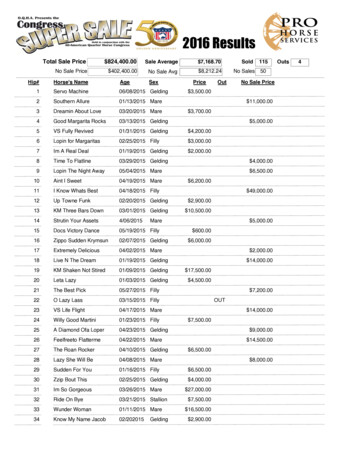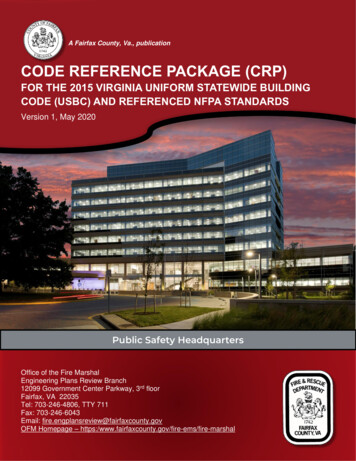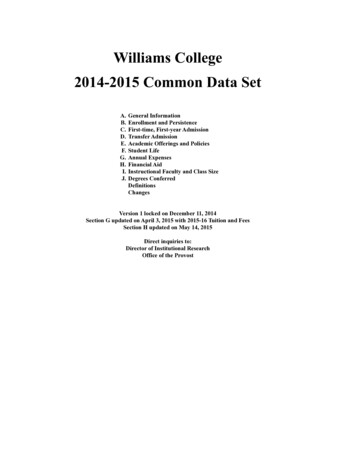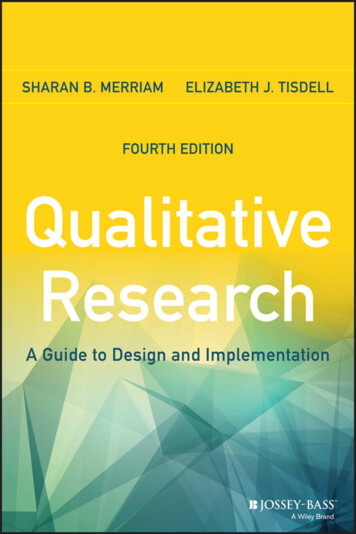
Transcription
WEBFFIRS06/08/201520:25:42Page ii
WEBFFIRS06/08/201520:25:42Page iQUALITATIVE RESEARCH
WEBFFIRS06/08/201520:25:42Page ii
WEBFFIRS06/08/201520:25:42Page iiiQUALITATIVERESEARCHA Guide to Design andImplementationFourth EditionSharan B. MerriamElizabeth J. Tisdell
WEBFFIRS06/08/201520:25:42Page ivCover design byCover image: Copyright 2016 by John Wiley & Sons, Inc. All rights reserved.Published by Jossey-BassA Wiley BrandOne Montgomery Street, Suite 1000, San Francisco, CA 94104-4594—www.wiley.com, www.josseybass.com/highereducationNo part of this publication may be reproduced, stored in a retrieval system, or transmitted in any form orby any means, electronic, mechanical, photocopying, recording, scanning, or otherwise, except aspermitted under Section 107 or 108 of the 1976 United States Copyright Act, without either the priorwritten permission of the publisher, or authorization through payment of the appropriate per-copy feeto the Copyright Clearance Center, Inc., 222 Rosewood Drive, Danvers, MA 01923, 978-750-8400, fax978-646-8600, or on the Web at www.copyright.com. Requests to the publisher for permission should beaddressed to the Permissions Department, John Wiley & Sons, Inc., 111 River Street, Hoboken, NJ07030, 201-748-6011, fax 201-748-6008, or online at www.wiley.com/go/permissions.Limit of Liability/Disclaimer of Warranty: While the publisher and author have used their best efforts inpreparing this book, they make no representations or warranties with respect to the accuracy orcompleteness of the contents of this book and specifically disclaim any implied warranties ofmerchantability or fitness for a particular purpose. No warranty may be created or extended by salesrepresentatives or written sales materials. The advice and strategies contained herein may not besuitable for your situation. You should consult with a professional where appropriate. Neither thepublisher nor author shall be liable for any loss of profit or any other commercial damages, includingbut not limited to special, incidental, consequential, or other damages. Readers should be aware thatInternet Web sites offered as citations and/or sources for further information may have changed ordisappeared between the time this was written and when it is read.Jossey-Bass books and products are available through most bookstores. To contact Jossey-Bass directlycall our Customer Care Department within the U.S. at 800-956-7739, outside the U.S. at 317-572-3986, orfax 317-572-4002.Wiley publishes in a variety of print and electronic formats and by print-on-demand. Some materialincluded with standard print versions of this book may not be included in e-books or in print-ondemand. If this book refers to media such as a CD or DVD that is not included in the version youpurchased, you may download this material at http://booksupport.wiley.com. For more informationabout Wiley products, visit www.wiley.com.Library of Congress Cataloging-in-Publication DataMerriam, Sharan B.Qualitative research : a guide to design and implementation / Sharan B. Merriam & Elizabeth J.Tisdell. – Fourth edition.pages cm – (The Jossey-Bass higher and adult education series)Includes bibliographical references and index.ISBN 978-1-119-00361-8 (paperback)ISBN 978-1-119-00365-6 (ebk.)ISBN 978-1-119-00360-1 (ebk.)1. Education–Research–Methodology. 2. Education–Research–Case studies. 3. Case method.4. Qualitative research. I. Tisdell, Elizabeth J. II. Title.LB1028.M396 2015370.72–dc232015005272Printed in the United States of AmericaFOURTH EDITIONPB Printing 10 9 8 7 6 5 4 3 2 1
WEBFFIRS06/08/201520:25:42Page vThe Jossey-Bass Higher andAdult Education Series
WEBFFIRS06/08/201520:25:42Page vi
WEBFTOC06/07/20152:40:37Page viiCONTENTSPrefaceThe AuthorsPART ONE: THE DESIGN OF QUALITATIVE RESEARCH1234What Is Qualitative Research?Six Common Qualitative Research DesignsExpanding the Qualitative Paradigm: MixedMethods, Action, Critical, and Arts Based ResearchDesigning Your Study and Selecting a SamplePART TWO: COLLECTING QUALITATIVE DATA567Conducting Effective InterviewsBeing a Careful ObserverMining Data from Documents and ArtifactsPART THREE: ANALYZING AND REPORTINGQUALITATIVE DATA8910ixxvii13224373105107137162191Qualitative Data AnalysisDealing with Validity, Reliability, and EthicsWriting Up Qualitative Research195237267Appendix: The Methodology Section of aQualitative Research Study293ReferencesName IndexSubject Index301323331Sharan B. Merriamvii
WEBFTOC06/07/20152:40:37Page viii
WEBFPREF06/07/20152:38:3Page ixPREFACEQualitative research is a mature field of study with its own literaturebase, research journals, special interest groups, and regularlyscheduled conferences. Indeed, staying current is a dauntingtask for any single individual. Van Maanen (2011) humorouslydescribes trying to “keep up” with developments in ethnography,just one type of qualitative research:The ethnography industry now includes the ceaseless production of authoritative monographs, exhaustive reviews of the literature(s), method manuals, encyclopedias of concepts andtheories, meta-critical expositions, themed anthologies, handbooks of door-stopping weight, established and quasi-establishedjournal publications, formal presentations of talks and paperspresided over by umpteen academic societies, online publications, blogs, topical chat-rooms, message boards, forums, socialnetworking sites, and on and on. The answer then to how a single person can keep up without gagging is that he or she can’t,for the potentially relevant materials are overwhelming, and newtheories, new problems, new topics, new concepts, and new critiques of older work multiply with each passing year. It seems thebest one can do is to selectively pursue and cultivate an everdiminishing proportion of the potentially relevant work thatcomes one’s way and assume an attitude of benign neglecttoward the rest. (p. 146)However, what has remained constant amidst the burgeoningof resources for doing qualitative research is the value of a practicalguide for designing and implementing this type of research.Qualitative Research: A Guide to Design and Implementation representsour effort to explain qualitative research in an easy-to-follownarrative accessible to both novice and experienced researchers.ix
WEBFPREF06/07/2015x2:38:3Page xPREFACEIn essence, it is a practical guide without being just a “cookbook”for conducting qualitative research; readers also come to understand the theoretical and philosophical underpinnings of thisresearch paradigm.This edition of Qualitative Research: A Guide to Design andImplementation represents the latest iteration in thinking aboutand understanding qualitative research. The first edition, published in 1988, centered on qualitative case study research; the1998 second edition featured qualitative research, with case study asa secondary focus. The 2009 third edition saw a further reductionin the attention to qualitative case studies. For this fourth editionthe focus is largely on interpretive/constructivist qualitativeresearch, of which qualitative case study is one common design,along with what we call a “basic” qualitative study, ethnography,grounded theory, narrative inquiry, and a phenomenologicalqualitative study. In fact, we have retained and updated thechapter on “types” of qualitative research because from ourexperiences teaching and conducting workshops, there is littleclarity about the differences among these approaches forresearchers new to qualitative research—hence, a chapterdevoted to differentiating among these common types, as wellas exploring their overlaps.There are two other substantive changes to this fourth editionof Qualitative Research: A Guide to Design and Implementation. First, wehave added a new chapter of research designs in which qualitativemethods are heavily used, often with other more quantitative and/or creative methods. This chapter reviews mixed methods, actionresearch, critical research, and arts based research. The secondsubstantive change in this edition is more attention to how technology permeates the process—as in, for example, online datasources and qualitative data analysis software packages.This book continues to be positioned in applied fields ofpractice. Participants in our workshops and courses have comefrom nursing, social work, management, allied health, administration, counseling, religion, business gerontology, and humanresource development, among others, as well as every subfieldof education. Although our field of practice is adult education, andtherefore there are many examples from education and adulteducation, we have made an effort to bring in examples from a
WEBFPREF06/07/20152:38:4Page xiPREFACExivariety of fields of practice. Certainly the design and implementation of a qualitative study is the same across these fields.Another defining characteristic of this book is its how-to,practical focus, wherein the mechanics of conducting a qualitativestudy are presented in a simple, straightforward manner. Designinga qualitative study, collecting and analyzing data, and writing theresearch report are topics logically presented and liberally illustrated to assist the new researcher desiring some guidance in theprocess. The revisions in these chapters have greatly benefitedfrom our having access to nearly a decade of additional resourcespublished since the third edition; our own research; our supervision of dozens of qualitative dissertations; and, in particular,Sharan’s conducting certificate programs in qualitative researchmethods in South Africa, Singapore, Malaysia, and South Korea.From these hands-on workshops have come techniques, resources,and strategies for assisting learners in understanding and conducting qualitative research. Thus for this fourth edition we draw uponrecent literature in the field as well as our own experiences withqualitative research. The intended audiences for this book, then,are practitioners and graduate students in applied fields of practicewho are interested in a basic understanding of how to design andconduct a qualitative study.OVERVIEWOF THECONTENTSThe organization of this text reflects the process of conducting aqualitative research investigation. Part One contains four chapters.The first is on the nature of qualitative research, the second coversseveral common types of qualitative research, and the third presents other designs in which qualitative methods constitute a majorpart of the methodology. The fourth explains the procedure fordesigning a qualitative study, from identifying a gap in the knowledge base, to forming a problem statement framed by the relevantliterature, to selecting the particular qualitative design most appropriate for your question, to selecting a sample. Part Two consists ofthree chapters that detail data collection techniques. The threechapters in Part Three deal with analyzing the data collected;handling concerns about reliability, validity, and ethics; and writingthe final report. We have also included in an appendix a qualitative
WEBFPREF06/07/2015xii2:38:4Page xiiPREFACEmethodology template created for graduate students who aredesigning a qualitative thesis or dissertation.Chapter One positions qualitative research within research ingeneral, discusses the roots of qualitative research in sociology andanthropology, and briefly describes early contributions in thedevelopment of qualitative research as a field itself. Next, thechapter reviews the philosophical/epistemological underpinningsof qualitative research as it contrasts with positivist (or quantitative), critical, and postmodern research traditions. Drawing fromits philosophical foundations, the chapter defines and then presents the characteristics of qualitative research. It closes with adiscussion of the investigator characteristics and skills needed toconduct a qualitative study.Writers have organized the variety of types of qualitative studiesinto various traditions or approaches. Chapter Two reviews six ofthe more common types of qualitative studies found across appliedfields of practice. The first type discussed is what we call a “basic”qualitative research study. This is by far the most common type ofqualitative study found in education and most likely in other fieldsof practice; other texts on qualitative research often fail to addressthe fact that you can conduct a qualitative study without its being aparticular type of qualitative study (such as a phenomenologicalstudy, a narrative inquiry, and so on). Other types of qualitativeresearch share all the characteristics of a basic qualitative study buthave an additional dimension. Other types and their uniquecharacteristics discussed in this chapter are phenomenology,grounded theory, ethnography, narrative analysis, and qualitativecase study research.Chapter Three presents several more recent and increasinglymore common types of research that have a major qualitativemethods component, and have contributed to expanding the qualitative paradigm in the past decade. These include mixed methoddesigns that make use of both qualitative and quantitative methods, action research, critical research, and arts based research(ABR). Action research is intended to solve a problem in practiceand make something happen in the research process itself,whereas critical research is specifically intended to challengepower relations. Arts based approaches incorporate one ormore multiple forms of art into the data collection and analysis
WEBFPREF06/07/20152:38:4Page xiiiPREFACExiiiprocess. There can be some overlap in these types of studies; forexample, arts based approaches can be incorporated into actionresearch, critical research, or other types of studies.Knowledge of previous research and theory can help aresearcher focus on the problem of interest and select the unitof analysis most relevant to the problem. Chapter Four explainswhat a theoretical framework is and shows how reviewing relevantliterature contributes not only to identifying the study’s theoreticalframework but also to shaping the problem statement. The problem statement lays out the logic and purpose of the study and iscritical to making informed decisions regarding sample selection(also covered in this chapter), data collection, and data analysis.Data collection techniques are covered in the three chapters inPart Two. Chapters Five, Six, and Seven examine the three primarymeans of collecting data in qualitative research. Interviews, discussed in Chapter Five, can range in structure from a list ofpredetermined questions to a totally free-ranging interview inwhich nothing is set ahead of time. The success of an interviewdepends on the nature of the interaction between the interviewerand the respondent and on the interviewer’s skill in asking goodquestions. Chapter Five also covers how to record and evaluateinterview data.Observations differ from interviews in that the researcherobtains a first-hand account of the phenomenon of interest ratherthan relying on someone else’s interpretation. Chapter Six discusses what to observe, the interdependent relationship betweenobserver and observed, and how to record observations in the formof field notes. Chapter Seven presents the third primary source ofqualitative data: documents and artifacts. The term document isbroadly defined to cover an assortment of written records, physicaltraces, and visual images. Although some documents might bedeveloped at the investigator’s request, most are produced independently of the research study and thus offer a valuable resourcefor confirming insights gained through interviews and observations. Chapter Seven covers various types of documents, their use inqualitative research, and their strengths and limitations as sourcesof data.Many general texts on qualitative research devote more spaceto theoretical discussions of methodology and data collection than
WEBFPREF06/07/2015xiv2:38:4Page xivPREFACEto the actual management and analysis of data once they have beencollected. However, we have discovered in our many years ofexperience teaching and conducting qualitative research thatthe most difficult part of the entire process is analyzing qualitativedata. We have also come to firmly believe that to learn how to doanalysis, there is no substitute for actually engaging in analysis,preferably with one’s own data. Nevertheless, in Chapter Eight wehave tried to present as clear a discussion as possible on how toanalyze qualitative data. The importance of analyzing data whilethey are being collected is underscored; some suggestions foranalysis early in the study during data collection are also included.Management of the voluminous data typical of a qualitative study isanother topic addressed in this chapter. The heart of the chapterpresents an inductive analysis strategy for constructing categoriesor themes that become the findings of the study. The chapter alsoincludes a discussion of the role of computer software programs inqualitative data analysis. The final section of this chapter reviewsdata analysis strategies particular to the types of qualitative researchdiscussed in Chapter Two (such as phenomenology and narrativeinquiry).All researchers are concerned with producing valid and reliablefindings. Chapter Nine explores the issues of validity and reliabilityin qualitative research. In particular, internal validity, reliability, andexternal validity are discussed, and strategies are offered for dealingwith each of these issues. Also of concern to researchers is how toconduct an investigation in an ethical manner, which in turn impactsthe trustworthiness of your study. Chapter Nine closes with a sectionon ethics, paying particular attention to ethical dilemmas likely toarise in qualitative research.Many an educator has been able to design a study, collectrelevant data, and even analyze the data, but then has failed to carrythrough in the important last step—writing up the results. Withoutthis step, the research has little chance of advancing the knowledgebase of the field or having an impact on practice. Chapter Ten isdesigned to help qualitative researchers complete the researchprocess by writing a report of their investigation. The first half ofthe chapter offers suggestions for organizing the writing process—determining the audience for the report, settling on the mainmessage, and outlining the overall report. The rest of the chapter
WEBFPREF06/07/20152:38:4Page xvPREFACExvfocuses on the content of the report—its components and where toplace them, how to achieve a good balance between descriptionand analysis, and how to disseminate the study’s findings.Finally, the appendix presents a template created for graduatestudents and others who would like some guidance in what goesinto a methodology chapter or proposal of a qualitative researchstudy. This template is an outline of the component parts of amethodology chapter, explaining what needs to be included undereach section. A modification of this outline could also be used forthe methodology section of a qualitative research grant proposal.ACKNOWLEDGMENTSWe want to acknowledge those who have contributed in variousways to this fourth edition. First, the three reviewers of the thirdedition provided extremely helpful suggestions for updating andorganizing this fourth edition. We also want to thank participants inworkshops on qualitative research in different parts of the worldwho raised wonderful questions and struggled with activitiesrelated to conducting small pilot studies—all of which enabledus to sharpen our thinking and instruction. We also want to givespecial thanks to our doctoral students, who, although they mayhave taken a number of courses in qualitative research, challengedus to improve our mentoring and advising as they worked throughthe process. We have, in fact, drawn examples from a number oftheir dissertations to illustrate aspects of the process. Finally, a veryspecial thanks goes to Anne Greenawalt, a doctoral student in thePenn State Adult Education program, for her assistance with a widerange of research, technical, and organizational tasks related togetting the manuscript ready for publication.SHARAN B. MERRIAMAthens, GeorgiaELIZABETH J. TISDELLHarrisburg, Pennsylvania
WEBFPREF06/07/20152:38:4Page xvi
WEBFLAST06/07/20152:36:1Page xviiTHE AUTHORSSharan B. Merriam is professor emerita of adult and continuingeducation at the University of Georgia in Athens, where herresponsibilities included teaching graduate courses in adult education and qualitative research methods and supervising graduatestudent research. She received her B.A. degree (1965) in Englishliterature from Drew University, her M.Ed. degree (1971) inEnglish education from Ohio University, and her Ed.D. degree(1978) in adult education from Rutgers University. Before comingto the University of Georgia, she served on the faculties of NorthernIllinois University and Virginia Polytechnic Institute and StateUniversity.Merriam’s main research and writing activities have focused onadult education, adult development and learning, and qualitativeresearch methods. She has served on steering committees for theannual North American Adult Education Research Conference, theQualitative Research in Education Conference at the University ofGeorgia, and the Commission of Professors of Adult Education. Forfive years she was coeditor of Adult Education Quarterly, the majorresearch and theory journal in the field of adult education. She wasalso coeditor of a book series, Professional Practices in Adult Educationand Lifelong Learning. She has won the Cyril O. Houle World Awardfor Literature in Adult Education for four different books. Various ofher books have been translated into Chinese, Korean, Japanese, andFrench. Her most recent publications include A Guide to Research forEducators and Trainers of Adults (with Patricia Cranton, 2015), AdultLearning (with Laura Bierema, 2014), Learning in Adulthood, thirdedition (with Rosemary Caffarella and Lisa Baumgartner, 2007),Non-Western Perspectives on Learning and Knowing (2007), and ThirdUpdate on Adult Learning Theory (2008).xvii
WEBFLAST06/07/2015xviii2:36:1Page xviiiTHE AUTHORSBased on her widespread contributions to the field of adulteducation, Merriam has been inducted into the InternationalAdult and Continuing Education Hall of Fame and was the firstto receive the American Association of Adult and ContinuingEducation’s Career Achievement award. She regularly conductsworkshops and seminars on adult learning and qualitative researchthroughout North America and overseas, including Brazil andcountries in southern Africa, Southeast Asia, the Middle East,and Europe. She has been a senior Fulbright scholar to Malaysia,and a distinguished visiting scholar to universities in South Koreaand South Africa.Elizabeth J. Tisdell is professor of adult education at Penn StateUniversity–Harrisburg and the coordinator of graduate programs in adult education. Her teaching responsibilities includefacilitating graduate courses in adult education, spirituality andculture in the health and medical professions, and in qualitative research methods. She also supervises graduate studentresearch.Tisdell received her B.A. in mathematics from the University of Maine in 1977, an M.A. in religion from FordhamUniversity in 1979, and an Ed.D. in adult education from theUniversity of Georgia in 1992. Prior to joining the faculty atPenn State, she was associate professor of adult and continuingeducation at National-Louis University in Chicago and servedon the faculty at Antioch University, Seattle. She worked as acampus minister for the Catholic Church from 1979 to 1989at both Central Michigan University and Loyola University–New Orleans.Tisdell’s main research and writing activities have focused onspirituality and culture in adult and higher education, diversityissues in adult education and medical education, and qualitativeresearch methods. She is the author of Exploring Spirituality andCulture in Adult and Higher Education (Jossey-Bass, 2003). Her otherscholarly works have appeared in numerous journals and editedbooks. Tisdell has served on steering committees for the annualNorth American Adult Education Research Conference, was thechair of the Commission of Professors of Adult Education from
WEBFLAST06/07/20152:36:1Page xixTHE AUTHORSxix2012 to 2014, and was coeditor of Adult Education Quarterly from2006 to 2011. Tisdell enjoys exploring what is to be learned fromspiritual pilgrimage, embodied in practices relating to yoga, music,and art, and from exploring both the wisdom in nature as well asthe nature of wisdom.
WEBFLAST06/07/20152:36:1Page xx
WEBFLAST06/07/20152:36:1Page xxiQUALITATIVE RESEARCH
WEBFLAST06/07/20152:36:1Page xxii
WEBPART0106/07/20152:42:45Page 1PART ONET H E D E S I G N OFQUALITATIVERESEARCHEducation, health, social work, administration, and other arenas ofsocial activity are considered applied social sciences or fields ofpractice precisely because practitioners in these fields deal with theeveryday concerns of people’s lives. Having an interest in knowingmore about one’s practice, and indeed in improving one’s practice,leads to asking researchable questions, some of which are bestapproached through a qualitative research design. In fact, webelieve that research focused on discovery, insight, and understanding from the perspectives of those being studied offers thegreatest promise of making a difference in people’s lives.Engaging in systematic inquiry about your practice—doingresearch—involves choosing a study design that correspondswith your question; you should also consider whether the designis a comfortable match with your worldview, personality, and skills.It is thus important to understand the philosophical foundationsunderlying different types of research so that you can makeinformed decisions as to the choices available to you in designingand implementing a research study. The four chapters in Part Oneof this book provide the conceptual foundation for doing qualitativeresearch and lay out some of the choices and decisions you willneed to make in conducting a qualitative study.
WEBPART0106/07/201522:42:45Page 2QUALITATIVE RESEARCH: A GUIDE TO DESIGN AND IMPLEMENTATIONThe qualitative, interpretive, or naturalistic research paradigmdefines the methods and techniques most suitable for collectingand analyzing data. Qualitative inquiry, which focuses on meaning in context, requires a data collection instrument that issensitive to underlying meaning when gathering and interpretingdata. Humans are best suited for this task, especially becauseinterviewing, observing, and analyzing are activities central toqualitative research. Chapter One explores the foundationsof qualitative research, defines this mode of inquiry, and identifies its essential characteristics.Although all of qualitative research holds a number of assumptions and characteristics in common, there are variations in thedisciplinary base that a qualitative study might draw from, in how aqualitative study might be designed, and in what the intent of thestudy might be. Thus a qualitative ethnographic study that focuseson culture could be differentiated from a narrative life history studyor from a study designed to build a substantive theory. Chapter Twodifferentiates among six major types of qualitative studies commonly found in applied fields of study.As the field of qualitative research continues to develop andexpand, we thought it useful to include a chapter that reviewsdesigns wherein qualitative methods are combined with otherorientations. Chapter Three reviews mixed methods, actionresearch, critical, and arts based research.Other considerations have to do with identifying the theoretical framework that forms the scaffolding or underlying structure ofyour study. Reviewing previous thinking and research found in theliterature can help illuminate your framework, as well as shape theactual problem statement and purpose of the study. Further, howyou select your sample is directly linked to the questions you askand to how you have constructed the problem of your study. Theseconsiderations are discussed in detail, with illustrative examples, inChapter Four.The four chapters that make up Part One of this book are thusdesigned to orient you to the nature of qualitative research andcommon types of qualitative research, as well as how to frame yourquestion or interest, state your research problem, and select asample. Part One paves the way for subsequent chapters that focuson data collection and data analysis.
WEBC0106/07/20152:3:30Page 3CHAPTER ONEW H AT I S Q U A L I T A T I V ERESEARCH?This book is about qualitative research—what it is, and how to do it.But before we get into qualitative research, it’s important to definewhat we mean by research itself. There are many definitions ofresearch, but what they all have in common is the notion ofinquiring into, or investigating something in a systematic manner.In everyday life we talk about “doing research” to inform ourdecisions and to decide on a particular course of action. Forexample, when it comes time to buy a new car, you might dosome “research” by consulting Consumer Reports and a number ofInternet sites that rate cars on quality, customer satisfaction, safety,and so on. All of this “research,” in addition to test-driving severalcars, will enable you to make your decision.You as a reader probably found your way to this text becauseyou have a more formal interest in research. Research is typicallydivided into the categories of basic and applied. Basic research ismotivated by intellectual interest in a phenomenon and has as itsgoal the extension of knowledge. Although basic research mayeventually inform practice, its primary purpose is to know moreabout a phenomenon. Al Gore, in his award-winning movie AnInconvenient Truth, shares quite a bit of basic research (such a
7 Mining Data from Documents and Artifacts 162 PART THREE:ANALYZING AND REPORTING QUALITATIVE DATA 191 8 Qualitative Data Analysis 195 9 Dealing with Validity, Reliability, and Ethics 237 10 Writing Up Qualitative Research 267 Appendix: The Methodology Section of a Qualitative Research Study 293 Sharan B. Merriam References 301 Name Index 323 .
